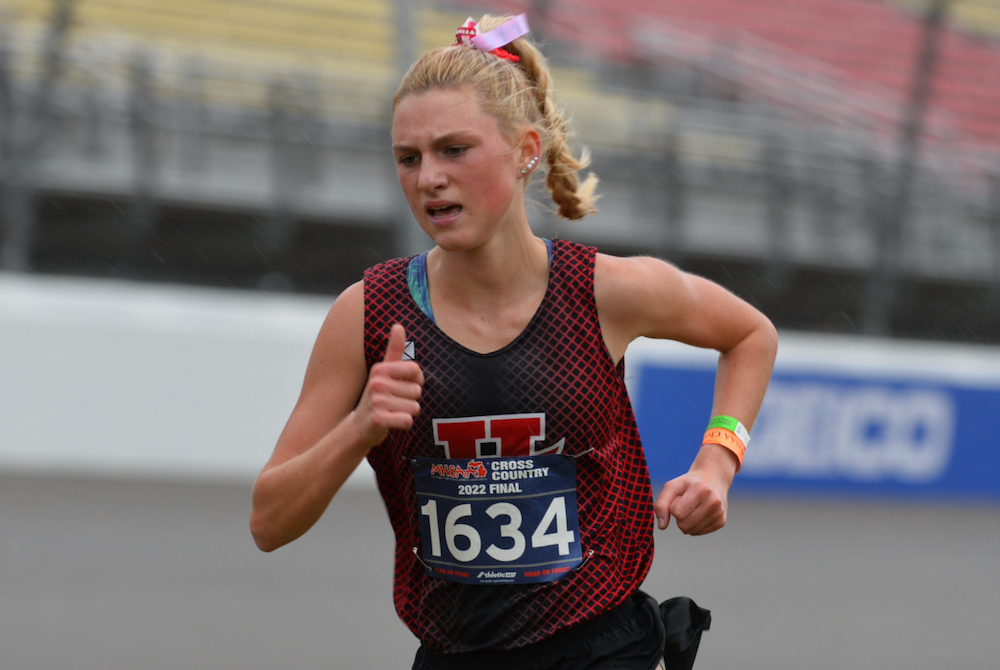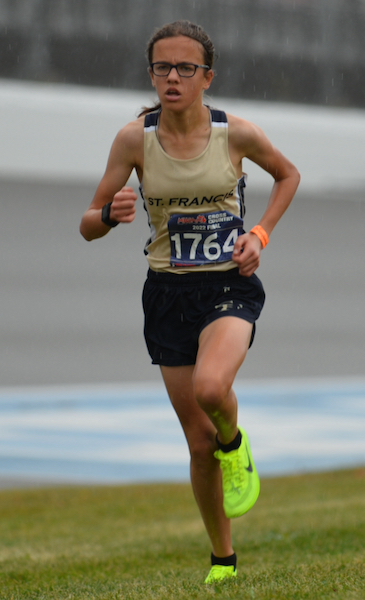
Munising Goes from No Team to Best
By
John Vrancic
Special for MHSAA.com
October 25, 2020
MUNISING — Hattie Cota was the lone runner on the Munising girls cross country team last year.
She became part of an Upper Peninsula championship team here Saturday as the Mustangs earned the Division 3 title with 54 points.
“We’re just so happy,” said Cota, who was individual runner-up on this partly sunny and chilly afternoon at Pictured Rocks Golf & Country Club. “I’m not used to being on a team, especially a good team.”
This marked the first title in seven years for the Mustangs, who were followed by three-time reigning champion Chassell with 73 points and Stephenson with 106.
“I’m just so excited,” said Munising coach Mark Kinnunen. “I thought it’d be many, many years before I’d have a championship team. We came in blind, not knowing who’d come out on top. We didn’t really know what to expect from Chassell. We told the girls to ‘run like you want to win.’ The only reason why we had a full team is because Hattie went out and recruited some girls.”
 Rock Mid Peninsula senior Daisy Englund won the individual title for the first time since her freshman year by covering the 3.1-mile course in 21 minutes, 16.4 seconds. Cota, who led much of the third mile, was clocked at 21:27. They were followed by Ewen-Trout Creek senior Elise Besonen (21:41).
Rock Mid Peninsula senior Daisy Englund won the individual title for the first time since her freshman year by covering the 3.1-mile course in 21 minutes, 16.4 seconds. Cota, who led much of the third mile, was clocked at 21:27. They were followed by Ewen-Trout Creek senior Elise Besonen (21:41).
"That was so scary,” said Englund, who ran a 6:17 split for her first mile. “I could hear Hattie after the second mile, and I kind of lost my focus for a little while. I knew everybody was going to be targeting me today and told myself I had to hang on. I finished strong, but I don’t know where that came from. I didn’t feel strong the whole race. I was cruising for sure in the first mile. This was my last high school cross country race. I just wanted to win so bad.”
Englund was trailing until the last turn when she used a strong surge to regain the lead.
“I was behind a bunch of girls.” said Cota. “I didn’t think I’d be able to catch her. Daisy ran a great race herself. Once she started pulling away (after the last turn), I knew I couldn’t catch her. I just didn’t have enough left.”
Mid Pen junior and last year’s champion Landry Koski took fourth this time at 21:46.7, and Stephenson senior Kylee Kuntze was fifth (21:47.5).
“This was one of my better races,” said Koski. “I actually felt pretty strong until the last mile. This was also the last race of the year. I had to leave it all on the course.
“I’m just so happy for Daisy. I’m also happy with the weather. This was better than I was expecting. The course was a little wet, but I just went through the puddles. I was going to get wet anyway.”
PHOTOS: (Top) Munising's Monique Brisson (143) and Hattie Cota (144) run in the Upper Peninsula Division 3 Final held at Pictured Rocks Golf Course in Munising. (Middle) Rock Mid Peninsula's Daisy Englund approaches the finish line on the way to winning the individual title. (Photos by Cara Kamps.)

Jazwinski Brings Hart Individual Title as St. Francis Moves to Front of Team Pack
November 5, 2022
BROOKLYN – Cross country races can be won between the ears before runners ever step foot onto the course.
Attitudes were tested as rain began to descend on Michigan International Speedway and the wind picked up just before the start of the MHSAA Lower Peninsula Division 3 girls race late Saturday morning.
Hart sophomore Jessica Jazwinski was loving life as she prepared to race.
“As a distance runner, I really try to love the wind,” she said. “Distance running and cross country is just a tough sport. The wind just adds to it — and the rain, too. It’s super fun.
“I was just thinking these conditions are just gonna feed my great race. This is real cross country. Yeah!”
Jazwinski overcame the elements to run the fifth-fastest Division 3 time ever, winning with a time of 17:36.70. She has two of the top-five times in Division 3 Finals history, having run 17:31.4 to place third last year.
“Today my race plan was just to go out hard and try to hold on to my pace,” she said. “I feel like I tried to race a lot like Steve Prefontaine, just go out and hold on.”
 Lansing Catholic senior Hannah Pricco was second in 18:17.59, Onsted sophomore Emmry Ross was third in 18:20.96 and Hart junior Alyson Ens was fourth in 18:28.52.
Lansing Catholic senior Hannah Pricco was second in 18:17.59, Onsted sophomore Emmry Ross was third in 18:20.96 and Hart junior Alyson Ens was fourth in 18:28.52.
“I love having great teammates to work with and encourage each other,” Jazwinski said. “We really try to encourage each other so much throughout the races. Throughout this year, some races she’s been a minute behind me, some races she’s been five seconds. I don’t want her to ever beat me, so that pushes me so much. I know she’s trying to race me and get up there with me.”
The only downer for Hart was having its string of Division 3 championships end at five with a fourth-place finish. Hart had two runners in the top four, but its No. 3 runner was 68th.
“I would totally trade my individual title for a team title,” Jazwinski said.
Traverse City St. Francis emerged from a close battle to win its first title since 2016 with 134 points. Pewamo-Westphalia was second with 142 and Lansing Catholic third with 165.
Sophomore Betsy Skendzel led St. Francis, placing seventh in 18:48.33. Completing the team score were senior Sophia Rhein in 26th (19:43.27), sophomore Grace Slocum in 33rd (20:07.95), junior Rylee Duffing in 60th (20:44.82) and junior Margot Hagerty in 63rd (20:45.78).
Lansing Catholic had three place in the top 10, but didn’t get another finisher until 103rd.
PHOTOS (Top) Hart’s Jessica Jazwinski pushes toward the finish during Saturday’s LPD3 Final. (Middle) Traverse City St. Francis’ Betsy Skendzel leads the way for the eventual team champion. (Click for more from Dave McCauley/RunMichigan.com.)

